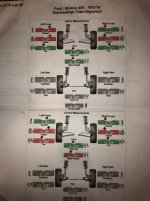How the hell did it get so out of wack when I lifted it?
It didn't. It's just that yours was set up pretty much this way at the factory.
Your camber was supposed to be between 1 and 2 degrees positive from the factory, and it is.
It does not change a notable amount when lifting.
Toe-in settings change with tire size when measured in inches, but when measured at a degree value like they do today does not. And it does not change notably due to a lift either. It might be measured on the machine, but not by eyeball usually.
Caster is what changes. A LOT!
Because the radius arms tilt when extended you change your caster towards the negative. The C-bushings are offset to compensate, but while it's enough to bring it back to original (or more in your case) that "original" was often crappy and well below expectations to begin with. General rule of thumb was that for a 3" lift you needed 4 degree bushings to bring it back to stock. The problem is that "stock" was usually very low to begin with back then. Hence the more common recommendation to go straight to the 7 degree bushings even with just a 2.5" lift.
So nothing unheard of in your case yet.
I added the proper additions that was recommend to ensure proper angles of the frontend. Now I am adding shims and other trinkets. Do other people have this issue?
Yes, a large majority of Broncos do need this stuff. Most don't get them however, and the owner just leaves it as is, as "good enough" for them. Or "too much hassle" to bother with for a weekend driver.
Some of the additions you added have nothing to do with alignment numbers on a machine. The trackbar drop and dropped pitman arm simply bring your steering linkage back down to a workable level. This is not part of an alignment, but will totally effect your driving experience due to the changes. But nothing to do with camber, caster or toe-in.
Only the C-bushings work in that arena, and only for caster. But if your Bronco started off low to begin with, you're still going to be low even after the compensation.
This is why we are always on about trying to get an alignment reading before doing a lift. This way you know which C-bushings to order before it's lifted, or even if the C-bushings alone will be enough.
Unfortunately most people don't have that option, as by the time we start talking about it here the Bronco is already in pieces.
When it's not, either they don't want to pay twice (understandable) or just don't want to hassle (also understandable) and so don't do it.
Or we forget to mention it, which happens too of course.
I look at the other broncos that have a homemade lift and there tires look spot on! What gives?
Their Broncos either started out in better shape alignment-wise, or they've already gone through the same thing and have dealt with it by the time you saw their Bronco.
And what constitutes a home-made lift? I would say that 95% of all lifted Broncos were done with off-the-shelf "standard" parts, whether mixed and matched, or bought as a system. The only thing home made in those cases is that the store-bought parts were installed at home.
Just like here in fact.
And like said, some Broncos came from the factory with better settings. Things were just not that consistent at the Dana/Spicer factory apparently.
But there is also the 40 to 50 years or hard use and abuse that some go through. It's not hard to bend up a front end when bouncing around off road. Or even on the road the way I've seen some people drive!
But again, yours is in the normal range for some things. That 1.2 degrees is well below the accepted max of 2 degrees. And your caster was probably perfectly acceptable when the rig was new with skinny little bias ply tires on it and the roads were in the shape they used to be in.
And back when we didn't know better how a vehicle could actually handle if designed right in the first place for that aspect of life.
Once this is out of whack.. its a bitch getting it back!
Not really. Just seems like it when it's unexpected. But much of what you're talking about right here is what we've all gone through. Sometimes multiple times.
Even without a lift, some of us that have had our Broncos for years drive around and decide to change the camber with the methods described, just to get it better than it came from the factory. Same with caster even without a lift.
Stock caster was supposed to be something like 2.5 to 4 degrees. But it was RARELY that especially in the pre-'73 years due to manual steering. More positive caster means harder steering. Even with the skinny tires that would have been unacceptable so they erred to the low side and we got stuck with 1.5 to 2 degrees of caster. Right about where you are now. It's just harder to enjoy with bigger tires and a new, higher center of gravity working against it. And you!
We'll hang in there and try to keep you from pulling all of your hair out!
Paul, I moved the tie-rod. Have a look I unbolted it and rolled it up. Does that look better?
Yes, much!
Paul














